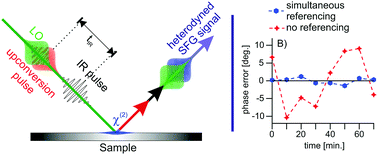当前位置:
X-MOL 学术
›
Phys. Chem. Chem. Phys.
›
论文详情
Our official English website, www.x-mol.net, welcomes your
feedback! (Note: you will need to create a separate account there.)
Detecting weak signals from interfaces by high accuracy phase-resolved SFG spectroscopy†
Physical Chemistry Chemical Physics ( IF 2.9 ) Pub Date : 2018-09-28 00:00:00 , DOI: 10.1039/c8cp04239j Martin Thämer 1, 2, 3 , R. Kramer Campen 1, 2, 3 , Martin Wolf 1, 2, 3
Physical Chemistry Chemical Physics ( IF 2.9 ) Pub Date : 2018-09-28 00:00:00 , DOI: 10.1039/c8cp04239j Martin Thämer 1, 2, 3 , R. Kramer Campen 1, 2, 3 , Martin Wolf 1, 2, 3
Affiliation

|
Much work over the last 25 years has demonstrated that the interface-specific, all-optical technique, vibrational sum frequency generation (v-SFG) spectroscopy, is often uniquely capable of characterizing the structure and dynamics of interfacial species. The desired information in such a measurement is the complex second order susceptibility which gives rise to the nonlinear response from interfacial molecules. The ability to detect molecular species yielding only small contributions to the susceptibility is meanwhile limited by the precision by which the spectral phase and amplitude can be determined. In this study we describe a new spectrometer design that offers unprecedented phase and amplitude accuracy for extended studies that involve multiple spectral acquisitions while modifying sample properties. The key to this significant improvement to the sensitivity of the technique is the combination of a full collinear beam geometry with broadband spectral sampling and the ability to simultaneously measure the complex sample and reference spectrum. We show that using this technique uncertainties in the reference phase and amplitude can be greatly reduced. Furthermore, we show that using balanced detection, the signal to noise ratio can be increased by one order of magnitude. The capabilities of the spectrometer are demonstrated by the isolation of a small isotropic surface signal from the bulk dominated nonlinear optical response of z-cut quartz. The achieved precision of our spectrometer enables measurements not currently feasible in v-SFG spectroscopy.
中文翻译:

通过高精度相位分辨SFG光谱仪检测来自接口的微弱信号†
过去25年的大量工作表明,特定于界面的全光学技术(振动和频率生成(v-SFG)光谱)通常具有表征界面物种的结构和动力学的独特能力。在这种测量中所需的信息是复杂的二阶磁化率,它会引起界面分子的非线性响应。同时,检测分子种类的能力仅对磁化率产生很小的贡献,同时又受到可确定光谱相位和幅度的精度的限制。在这项研究中,我们描述了一种新的光谱仪设计,该光谱仪为扩展的研究提供了空前的相位和幅度精度,这些研究涉及多个光谱采集,同时修改了样品特性。这项技术灵敏度显着提高的关键是将完整的共线光束几何形状与宽带光谱采样技术相结合,并能够同时测量复杂的样品和参考光谱。我们表明,使用这种技术可以大大降低参考相位和幅度的不确定性。此外,我们表明,使用平衡检测可以将信噪比提高一个数量级。通过将小的各向同性表面信号与z切割石英的主体支配的非线性光学响应隔离开来,证明了光谱仪的功能。我们的光谱仪达到了很高的精度,可以进行v-SFG光谱中目前尚不可行的测量。
更新日期:2018-09-28
中文翻译:

通过高精度相位分辨SFG光谱仪检测来自接口的微弱信号†
过去25年的大量工作表明,特定于界面的全光学技术(振动和频率生成(v-SFG)光谱)通常具有表征界面物种的结构和动力学的独特能力。在这种测量中所需的信息是复杂的二阶磁化率,它会引起界面分子的非线性响应。同时,检测分子种类的能力仅对磁化率产生很小的贡献,同时又受到可确定光谱相位和幅度的精度的限制。在这项研究中,我们描述了一种新的光谱仪设计,该光谱仪为扩展的研究提供了空前的相位和幅度精度,这些研究涉及多个光谱采集,同时修改了样品特性。这项技术灵敏度显着提高的关键是将完整的共线光束几何形状与宽带光谱采样技术相结合,并能够同时测量复杂的样品和参考光谱。我们表明,使用这种技术可以大大降低参考相位和幅度的不确定性。此外,我们表明,使用平衡检测可以将信噪比提高一个数量级。通过将小的各向同性表面信号与z切割石英的主体支配的非线性光学响应隔离开来,证明了光谱仪的功能。我们的光谱仪达到了很高的精度,可以进行v-SFG光谱中目前尚不可行的测量。











































 京公网安备 11010802027423号
京公网安备 11010802027423号